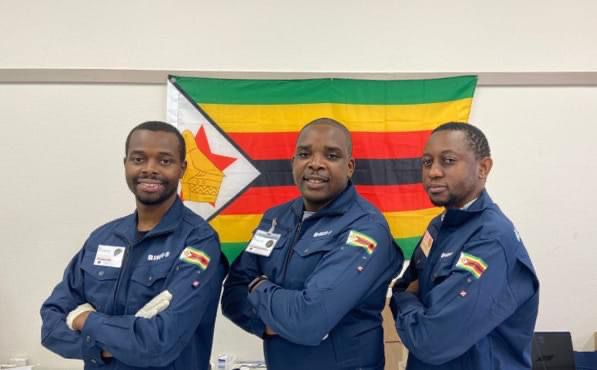Tinashe Kuhamba a Scientist and former Zimbabwe Broadcasting Corporation (Zbc) Engineer and his other two teammates made history recently by launching Zimbabwe’s first ever Satelite launch ZIMSAT-1 which is already improving lives on the ground as the country awaits the launch of ZIMSAT-2.Zimbabwe and Uganda join an ever growing number of African countries that are building up their space technology capabilities. To date, 52 satellites have been launched by 14 African countries, including the two launched last week.
These satellites, which have by now reached the International Space Station, are set to be deployed over the next few weeks, depending upon environmental conditions.
Engineer and Scientist Kuhamba exclusively revealed to TechnoMag, “The journey that started as a vision to change the prospects of his country through Satelite Technology.”
“You remember me from our Zbc Days as workmates, I was always pushing Technology especially greater Satelite involvement including programs I introduced and collaborated on Zbc Tv and here and there guys like you Ross , and the likes of Miriam would give me a slot either on your news time or program slots. Satelite Engineering has always been a passion I drove.”
This was a historic moment for the two countries, who now hope the data collected by the satellites will help improve life on the ground.
South Africa was the first African country on the continent which had dared done something almost similar with Uganda also now following in Zimbabwe’s footsteps amongst many other African States prioritizing Science and Technology.
Bonny Omara worked with Edgar Mujuni at Japan’s Kyushu Institute of Technology on the satellite that will be used to observe land conditions in Uganda.
Uganda’s very first satellite was launched into space last week on Nov. 7, with Bonny Omara, the lead engineer on the satellite development team, filled with emotion.
“I was watching it on TV, together with my Honourable Minister for Science, Technology and Innovation,” he says. “It was really amazing and we hugged each other! To see my baby takeoff from the ground headed for the International Space Station — it’s really a great feeling of my life.”
This satellite developed by Omara and his team, named PearlAfricaSat-1, was launched aboard a Northrop Grumman Cygnus resupply spacecraft, which lifted off from NASA’s Wallops Flight Facility in Virginia.
The rocket was also carrying ZimSat-1, Zimbabwe’s first satellite.
These two satellites were developed through the Joint Global Multi-Nation Birds Project 5, BIRDS-5, in collaboration with the Kyushu Institute of Technology in Japan. Omara, when asked about collaborating with engineers from Zimbabwe and Japan, said, “I feel really great to work with our neighbors in Africa … to have a team of engineers and great men joining hands to work together towards attaining a common goal.”
Bonny Omara added
“Space technologies are essentially the backbone of the modern economy,” said Kwaku Sumah, founder of SpaceHubs Africa, a service company that helps stimulate the African space ecosystem. “You sometimes don’t even know that you’re using them. But for example, if you’re using Google Maps … or even things like Zoom, or broadband communication, that’s all powered by satellite services.”
SpaceHubs Africa and Sumah were not involved in the development of the recently launched satellites.
Nevertheless, Zimbabwe and Uganda’s satellites won’t be providing wireless services to anyone. Instead, they’ve been developed for the purposes of earth observation.
“[The satellites] have a multispectral camera, which allows the satellite to essentially take pictures of the Earth,” said Sumah.
There are Multispectral cameras which can take pictures that capture information from wavelengths of light not visible to the human eye.
This in turn provides data that can help determine the health of land for the agricultural sector, among other things.
Omara sang from Zimbabwe’s Kuhamba’s hymn book that the multispectral camera will be used to “perform analysis of water quality, land use cover, and soil fertility.”
This information will then be provided to citizens so that they can make the best use of the natural resources in their countries.
There are however still possibilities to do even more with the satellites. Sumah says that one of the main purposes of a satellite Ghana launched in 2019 was to “monitor illegal mining that was occurring in the north of Ghana.”
All of those capabilities are made possible by a satellite that only measures 10cm in each direction. They’re called CubeSats — and their small size and low cost to develop makes them perfect first satellites for nations developing their space technology sectors.
Do not let their size fool you. While small – only a bit larger than a Rubik’s cube — CubeSats can still pack a big punch.There is one downside to CubeSats. Their lifetime of operation is only about 24 to 30 months.
Unless Zimbabwe and Uganda commit to building and launching more of these satellites, the benefits will be short-lived.
This is one small step for Africa, but giant leaps are still needed as the satellites launched by Zimbabwe and Uganda are not the first satellites launched by African nations, and they won’t be the last. According to Sumah, “Ethiopia is looking to launch a new satellite, as well as Nigeria and Ghana,” all hopefully within the next year.
In spite of plans for future launches by African nations, Sumah is a bit hesitant to suggest bigger things are unquestionably on the way. “I’m hoping that these are not just one-off events that are just used for PR, but that there’s a sustained momentum that helps lead the charge for Africa to really maximize the use of these new technologies.”
Engineers from Uganda Edgar Mujuni , Bonny Omara and Derrick Tebusweke helped launch their country’s first satellite.
Omara believes one thing will help make sure this new foray into space will be sustainable. “A couple of countries have launched their first satellite, or even many, by paying money to other institutions who then give them the satellite,” he says. “But Uganda is unique in the sense that we participated, we have now got three engineers who are fully grounded in the process of developing satellites.”
Though the human capital is there to provide sustainable development of satellites, Omara thinks there’s still more political and social investment needed before space technologies in Africa can fully mature.
“In the field of science and technology on the African continent, we are still limping,” he says. “The reason is very simple — it’s because we do not believe in ourselves. I always tell everyone that we can make it, we have every single resource that we need. The only thing is us believing in ourselves.”
As they say Big things come in small packages, many of the modern devices we use every day function because of satellite technology — something that’s often taken for granted.
The satellite from Uganda’s is small, but packs a punch. It will be able to transmit data that will help Ugandans make the best use of their natural resources.









Comments